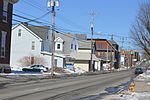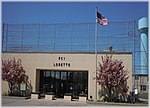Benjamin Franklin Jones Cottage

The Benjamin Franklin Jones Cottage (also known as Braemar Cottage) is a cottage on the National Register of Historic Places in Cresson Township, Cambria County, Pennsylvania, United States.In 1990, the mansion was purchased by a group that desired to restore it. In November 2009, a county judge declared the declining property a nuisance and ordered that it be demolished. When the historical group appealed to the Pennsylvania Commonwealth Court, the town supervisors agreed to postpone the demolition until May 2010. A request for a $150,000 grant that the group hoped could fund renovations was rejected.The structure was saved from demolition in 2011 when it was purchased by a Cresson, Pennsylvania couple who intended to restore it.
Excerpt from the Wikipedia article Benjamin Franklin Jones Cottage (License: CC BY-SA 3.0, Authors, Images).Benjamin Franklin Jones Cottage
3rd Street, Cresson Township
Geographical coordinates (GPS) Address Nearby Places Show on map
Geographical coordinates (GPS)
| Latitude | Longitude |
|---|---|
| N 40.4575 ° | E -78.591666666667 ° |
Address
3rd Street 1299
16630 Cresson Township
Pennsylvania, United States
Open on Google Maps










